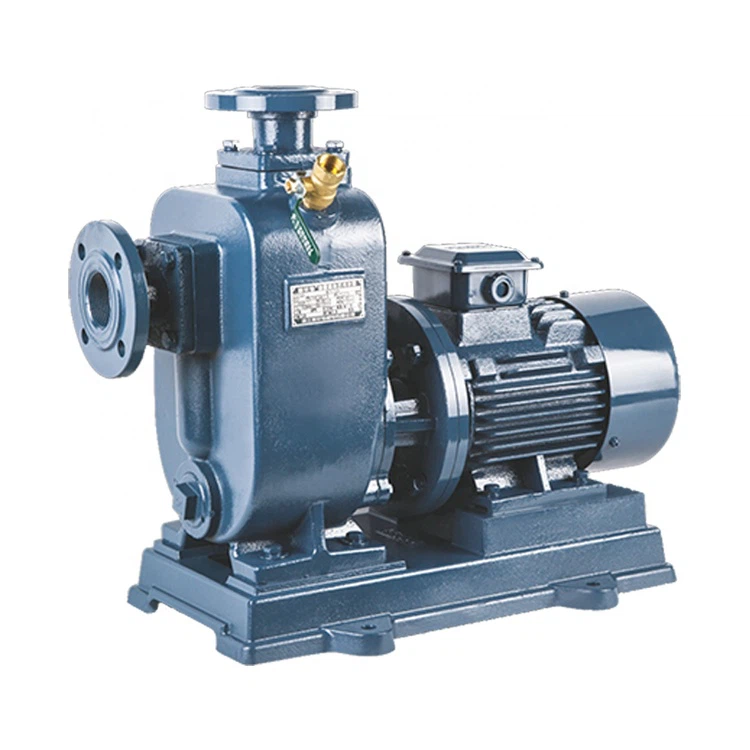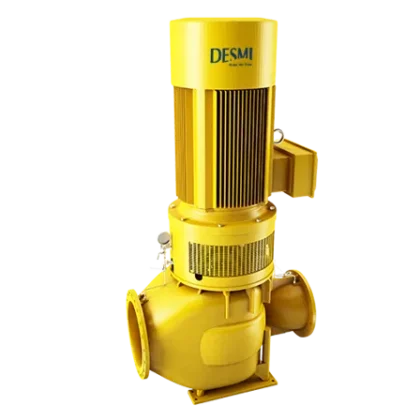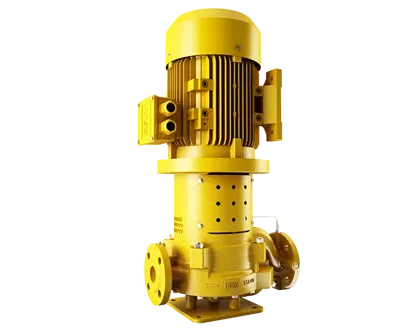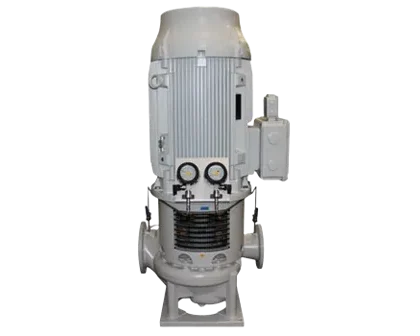A horizontal self-priming centrifugal pump is a specialized type of pump widely used in marine and industrial applications.1 Its name describes its key features: the shaft is oriented horizontally, it uses a rotating impeller to move fluid (centrifugal action), and most importantly, it has the ability to automatically “prime” itself by lifting liquid from a source below the pump’s level without the need for an external vacuum pump or foot valve.
Working Principle
The pump’s operation is based on the standard centrifugal action but with an added feature to handle air.2
- Priming Cycle: When the pump is first started, its casing is filled with a mixture of air and liquid (usually a small amount left from a previous operation). The impeller circulates this mixture, creating a low-pressure area at the impeller’s “eye.”
- Air Separation: The air, being lighter than the liquid, is separated and discharged through the pump’s discharge port. The liquid, being heavier, remains in the casing and is recirculated.
- Vacuum Creation: As air is expelled from the suction line and discharge port, a vacuum is created in the suction line. This vacuum allows atmospheric pressure to push the liquid up the suction line into the pump casing.
- Pumping Cycle: Once the pump casing is filled with liquid, the pump operates as a normal centrifugal pump, with the impeller’s rotation generating the velocity and pressure needed to move the fluid.
This self-priming capability is a significant advantage in applications where the pump is located above the fluid source.3
Main Components and Materials
A horizontal self-priming centrifugal pump shares many components with a standard centrifugal pump but has a unique casing design.
- Pump Casing: A larger casing that incorporates a “priming chamber” or reservoir to hold the liquid required for the priming cycle.4
- Impeller: The heart of the pump, a rotating disc with vanes that imparts centrifugal force to the liquid.5
- Volute/Diffuser: A specially shaped chamber in the casing that converts the high-velocity fluid from the impeller into high pressure.
- Suction Check Valve: An internal check valve that prevents the liquid in the pump casing from draining back into the suction line when the pump stops.6
- Mechanical Seal: A critical component that prevents fluid from leaking out of the pump around the shaft.7
- Bearings: Support the pump shaft.
- Motor: The electric motor or other power source that drives the pump.
Materials: The choice of material depends on the fluid being pumped.8 Common materials include:
- Cast Iron / Ductile Iron: For fresh water and general service.
- Bronze / Gunmetal: Excellent corrosion resistance for seawater and bilge applications.
- Stainless Steel: For corrosive fluids or food-grade applications.9
- Impeller: Often bronze, stainless steel, or ductile iron.
Marine Applications and Maintenance
The self-priming pump is indispensable on a ship where pumps are often located in the engine room, above the fluid levels of bilge wells, ballast tanks, or sea chests.
- Common Applications:
- Bilge and Ballast Pumps: The most common application, allowing the pump to draw from multiple compartments without a separate priming system.
- Emergency Fire Pumps: The ability to immediately lift water from a sea chest makes these pumps highly reliable in an emergency.
- General Service Pumps: Used for various tasks on board, such as deck washing or other utility services.
- Maintenance:
- Mechanical Seal: Regular inspection of the mechanical seal for leaks is crucial. A failing seal can lead to a loss of prime.
- Bearings: Proper lubrication and regular inspection of the bearings are essential.
- Impeller: Check the impeller for signs of corrosion or clogging.
- Priming: Ensure the pump casing has enough fluid to prime itself.10
Common Spares
A vessel’s spares inventory for these pumps should include:
- Mechanical Seal: A complete mechanical seal kit.
- Impeller: A spare impeller is a crucial part in case of damage or excessive wear.
- Gaskets and O-rings: For pump casing and other parts.
- Bearings: Spare bearing sets.
- Shaft: A spare pump shaft.
Horizontal self-priming centrifugal pumps are a reliable and vital component for fluid management on a vessel, particularly in safety-critical systems.
We offer an extensive range of marine engine brands and their associated spare parts, providing comprehensive solutions for both main propulsion and auxiliary power needs across diverse vessel types. Our supply capability covers various generations and models, ensuring support for a wide array of marine applications.
Featured Brands and Engine Series/Models:
SULZER:
- Two-Stroke Engines:
- RD/RND Series: RD68, RND76, RND76M, RND90, RND90M (Classic large-bore, low-speed engines, still in operation).
- RLA/RLB Series: RLA(B)56, RLA(B)66, RLA(B)76, RLB90 (Developed two-stroke designs).
- RTA/RT-Flex Series: RTA38, RTA48(T), RTA52, RTA58, RTA62, RTA72, RTA76, RTA84, RTA84M, RTA84C, RTA96 (Modern, fuel-efficient, electronically controlled two-stroke engines).
- Four-Stroke Engines:
- Z Series: ZL40/48, 16ZAV40S (Medium-speed engines).
- RF Series: RF44, RF56 (Often used for auxiliary power or generator sets).
- TAD Series: TAD36, TAD48 (For specific applications).
MAN (including pre and post-MAN B&W models):
- Two-Stroke Engines (KZ, KSZ, K, L, S, MC/MC-C, ME/ME-C): 40/54A, 52/90N, 57/80C, KZ57/80F, KSZ70/125, KSZ78/155, 90/160A, 52/55L, 58/64, 90/190C, L60/105E, 70/120E, 70/125C, L, KSZ78/155A, KSZ70/125B, L52/55A, 40/45 (A broad spectrum covering main propulsion and auxiliary engines).
B&W (Burmeister & Wain – prior to MAN B&W merger):
- MC/MCE Series: L35MC, L60MC, L80MC, L55GFCA, L80GFCA, L80GB, 74VT2BF, K62EF, K74EF, K84EF, K45GFC, K67GFK, K80GFK, K90GFS, 45HU, L70MC (Various generations of two-stroke diesel engines).
- MC-C/ME-C Series: L50MC, S60MC, S70MC, K80MC, S80MC, K90MC-C, L67GFCA, L90GB (Electronically controlled and conventional two-stroke engines).
- VT2BF/EF Series: 50VT2BF, 62VT2BF, K84EF (Older models still in service).
MITSUBISHI:
- UEC/UET Series: UEC37L/LA/LS, UEC45HA, UEC60L/LA/LS, UEC45L/LA/LS, UET45/75C, UEC52/125H, UEC52L/LA/LS, UET45/80D, UEC52/90D, UEC(T)52/105D, UEC45/115H, UEC37/88H, UEC37H (Mitsubishi’s proprietary two-stroke and some four-stroke engine series).
PIELSTICK:
- PA Series: PA6, PC3, PC2-2, IHI PC2-5, PC4, PC2-6, PC4-2L, PC4-570, PA5 (High-speed, compact four-stroke engines, commonly used for generator sets or auxiliary propulsion).
AKASAKA:
- UET/UEC/DM/AH Series: UET45/80D, UEC52/105D, DM51SS, UEC 60/150H, UEC 60H, A31, A34, A37, A41, AH27, AH28, AH30, AH36, AH38, AH40, DM30, DM36, DM38, DM46, DM47 (A prevalent engine brand, particularly in Japanese-built vessels).
DEUTZ:
- RBV/TBD/BVM Series: RBV8M358, RBV8M540, RBV16M640, TBD620L6, BVM350, BVM540, BF6M716 (Various four-stroke medium- and high-speed diesel engines for auxiliary and smaller main propulsion applications).
HANSHIN:
- EL/LH/LU/LUN/LUD/LUS Series: EL30, EL32, EL35, EL40, EL44, LH28RG, LH31G, LU28(A,R,G), LU32, LU35, LU38, LU46(A), LU50, LU54, LUN28, LUN30, LUD32, LUD35, LUS38 (Another significant engine brand commonly found in Japanese vessels).
NIIGATA:
- MG/M Series: MG40X(EX), M34X, 6M28BF, TM31X (Medium-speed diesel engines, typically used in small and medium-sized vessels).
MAK:
- M/MU/AK/AKM Series: M332, M453AK, MU551AK, MU552AK, M601, MU452AK, 451AK, 6M453AK, 9M453C, 6M601C, 8M601 (Medium-speed four-stroke engines, widely used in various marine applications).
WARTSILA:
- 20/22/26/32/38/46/GD/TKR Series: 22, 32, 31, 26, 20S, 28, 38, 46, 32GD, 46GD, 14, TKR22, HFR-V32, NOHAB (Wärtsilä’s broad portfolio of medium- and high-speed diesel engines for main propulsion, auxiliary, and generator sets).
DAIHATSU:
- PS/PKT/DS/DL/DK/PL Series: PS-18, PS-22, PS-20, PS-26, PS-30, PKT-14, PKT-16, PKTD-16, DS-18, DS-22, DS-26, DS-28, DS-32, DL-14, DL-16, DL-19, DL-20, DL-22, DL-24, DL-26, DK-20, PL-24 (Compact and reliable engines primarily used for auxiliary power and generator sets).
CUMMINS:
- BT/CT/NT/KTA/QSK/QSM Series: 4BT3.9, 6BT(A)5.9, 6CT8.3, NT(A)855, N14, KTA19, KTA38, KTA50, QSK19, QSM11 (Robust and durable engines for marine auxiliary power, generator sets, and some smaller main propulsion applications).
CATERPILLAR:
- 3000/3100/3300/3400/3500/3600 Series & C Series: 3054, 3056, 3066, 3106, 3126, 3306, 3406, 3408, 3412, 3508, 3512, 3516, 3606, 3608, 3612, 3616, 3618, C1.5, C2.2, C7, C9, C10, C12, C15, C16, C18, C30, C32 (Reliable and widely used engines across a vast range of main propulsion, auxiliary, and generator set applications).
SCANIA:
- DI Series: DI 09, DI 13, DI 16 (High-performance diesel engines designed for marine applications, typically used as auxiliary and smaller main propulsion engines).




